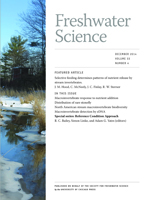One common stoichiometric approach to predicting patterns of nutrient release (excretion egestion) by animals in aquatic ecosystems is to base predictions on elemental mass-balance constrained by homeostatic maintenance. An easily measured resource composite (i.e., seston, epilithon, or leaf litter) often is used to represent ingested stoichiometry, but whether such a composite is a good indicator of food actually ingested is a relatively unexplored assumption. We examined the application of a stoichiometric model to the diets of 4 generalist stream invertebrates. We fed 3 trichopteran and 1 amphipod taxa rations consisting of cultured algae, stream epilithon, and several species of conditioned leaf litter. The rations ranged widely in C:N from 10 to 69 (molar) and in C: P from 165 to 3500. After a 2-d feeding period, we measured NH4 and PO43- excretion, and C, N, and P egestion rates. The relationships observed between the stoichiometries of release and ration were unexpected. Total N: P release rates conformed to stoichiometric predictions for only 1 taxon. Excretion and egestion rates and ratios were generally similar across diets and rarely varied with ration stoichiometry. These patterns were the result of smaller-than-expected responses to leaf-litter rations, which were the most imbalanced relative to body stoichiometry. Analysis of the C:N stoichiometry of foregut material for 2 taxa showed selective ingestion of an N-rich fraction of leaf litter, in 1 case reducing an apparent 8.4:1 C:N imbalance between diet and body composition to 1.5:1. Our results show that selective feeding can reduce potential stoichiometric imbalances, altering patterns of nutrient release relative to expectations based on bulk-diet stoichiometry. Assuming that stream invertebrates consume materials stoichiometrically similar to a resource composite can obscure understanding of stoichiometric imbalances and the role of invertebrates in nutrient cycles.
How to translate text using browser tools
19 September 2014
Selective Feeding Determines Patterns of Nutrient Release by Stream Invertebrates
James M. Hood,
Camille McNeely,
Jacques C. Finlay,
Robert W. Sterner
ACCESS THE FULL ARTICLE
It is not available for individual sale.
This article is only available to subscribers.
It is not available for individual sale.
It is not available for individual sale.

Freshwater Science
Vol. 33 • No. 4
December 2014
Vol. 33 • No. 4
December 2014
consumer-driven nutrient recycling
ecological stoichiometry
egestion
excretion
selective feeding
streams




